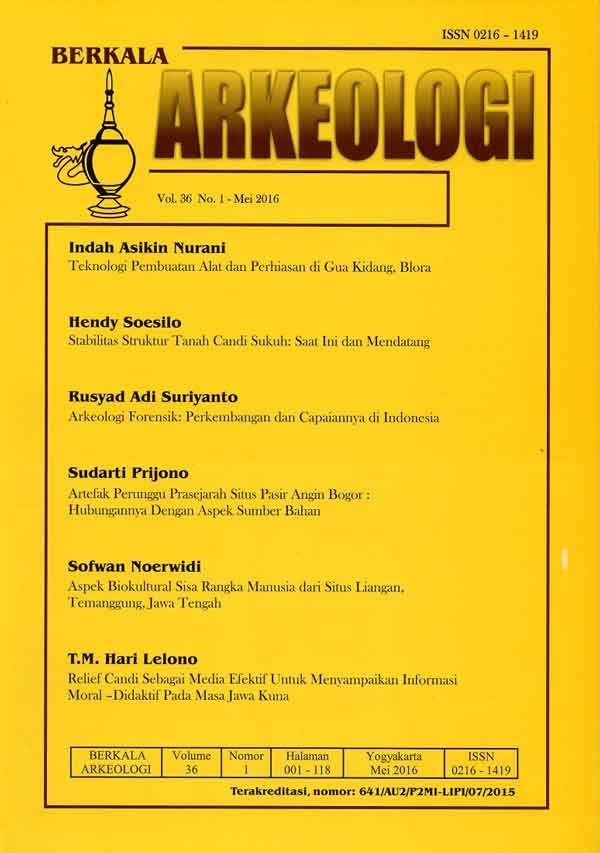ASPEK BIOKULTURAL SISA RANGKA MANUSIA DARI SITUS LIANGAN, TEMANGGUNG, JAWA TENGAH
Main Article Content
Abstract
Article Details

This work is licensed under a Creative Commons Attribution-NonCommercial-ShareAlike 4.0 International License.
References
Enoki K., Dahlberg A.A. 1958. “Rotated maxillary central incisorsâ€, Orthod J Jpn 17, pp. 157.
Hanihara K., Tanaka T., Tamada M. 1970. “Quantitative analysis of the shovelshaped character in the incisorsâ€, J Anthropol Soc Nippon 78, pp. 90–93.
Holland, S.M. 2006. Cluster Analysis. University of Georgia
Jørgensen K.D. 1955. “The Dryopithecus pattern in recent Danes and
Dutchmenâ€, J Dent Res 34, pp. 195–208.
Lovejoy, C.O. 1985. “Dental wear in the Libben population: Its functional pattern and role in the determination of adult skeletal age at death. American Journal of Physical Anthropology 68. pp. 47-56.
Matsumura, H. dan Oxenham, M.F. 2014. Demographic Transitions and Migration in Prehistoric East/Southeast Asia Through the Lens of
Nonmetric Dental Traits,
Noerwidi, Sofwan. 2012. “The significant of the Holocene human skeleton Song Keplek 5 in the history of human colonization of Java: A comprehensive morphological and morphometric studyâ€, International Master Thesis in Quaternary and Prehistory, Paris: MNHN
Rangkuti, Nurhadi. dan Tjahjono, Baskoro. D. 2000. “Laporan Peninjauan Situs Liyangan, Temanggung, Laporan Penelitian, Yogyakarta: Balai Arkeologi
Riyanto, S. 2011. “Integrasi Data, Gambaran Rekonstruktif, dan Kronologi Situs Liyanganâ€, Berita Penelitian Arkeologi No. 25, Yogyakarta: Balai Arkeologi, pp. 45-61
__________. 2012. “Kawasan Situs Liyangan: Luasan, Bentuk, Ragam Komponen Permukiman, serta Hubungan Fungsional antar Komponen dan Ruangnyaâ€, Berita Penelitian Arkeologi No. 25, Yogyakarta: Balai Arkeologi, pp. 60-72
Rooney, D.F. 1993. Betel Chewing Traditions in South-East Asia, Oxford: University Press
Saheki M. 1958. “On the heredity of the tooth crown configuration studied in twinsâ€, Acta Anat Nipponica 33, pp. 456–470.
Scott, G.R. 1973. “Dental morphology: A genetic study of American White families and variation in living Southwest Indiansâ€. PhD dissertation, Arizona State University
Soejono, R.P. 1977. “Sistem-sistem penguburan pada akhir masa prasejarah di Baliâ€, Doctoral Thesis, University of Indonesia
Suzuki M. dan Sakai T. 1973. The Japanese dentition, Matsumoto: Shinshu Univ Press.
Tim Penelitian. 2013. “Laporan Penelitian Arkeologi: Situs Liangan,
Temanggung, Jawa Tengahâ€, Laporan Penelitian Arkeologi, Yogyakarta: Balai Arkeologi
__________. 2014. “Laporan Penelitian Arkeologi: Situs Liangan, Temanggung, Jawa Tengahâ€, Laporan Penelitian Arkeologi, Yogyakarta: Balai Arkeologi Turner CG II, Nichol CR, Scott GR. 1991. “Scoring procedures for key morphological traits of the permanent dentition: The Arizona State University dental anthropology systemâ€, dalam Kelly M.A., Larsen C.S., eds., Advances in dental anthropology, New York: Wiley-Liss, pp. 13–31.
White, T.D. dan Folkens, P.A. 2005. The Human Bone Manual. United Kingdom: Elsevier, Inc.

